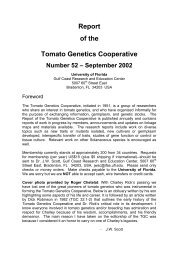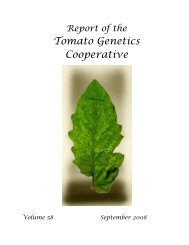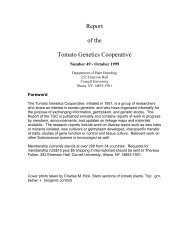Volume 60 - Tomato Genetics Cooperative - University of Florida
Volume 60 - Tomato Genetics Cooperative - University of Florida
Volume 60 - Tomato Genetics Cooperative - University of Florida
You also want an ePaper? Increase the reach of your titles
YUMPU automatically turns print PDFs into web optimized ePapers that Google loves.
esistance and agro-climatic adaptation to French West Indies conditions, together with<br />
resistance to Begomoviruses (Ano et al., 2002; Ano et al., 2004).<br />
Taiwan<br />
AVRDC started tomato breeding in 1972, and from 1973-1980 emphasized the<br />
development <strong>of</strong> breeding lines with heat-tolerance and bacterial wilt resistance (Opena<br />
et al., 1989). Sources <strong>of</strong> BW resistance frequently used as parents in AVRDC breeding<br />
included varieties „Venus‟ and „Saturn‟ from North Carolina State <strong>University</strong> and lines<br />
„VC 11-3-1-8‟, „VC 8-1-2-7‟, „VC 48-1‟ from the <strong>University</strong> <strong>of</strong> the Philippines. Most<br />
AVRDC bacterial wilt resistant lines developed in the 1970‟s such as „CL8d-0-7-1‟<br />
(derived from „VC11-1-2-1B‟ x „Venus‟), „CL9-0-0-1-3‟ (derived from „VC11-1-2-1B‟ x<br />
„Saturn‟), and „CL11d-0-2-1‟ (derived from „VC9-1-2-9B‟ x „Venus‟) were bred from<br />
crosses <strong>of</strong> these two sources. Many AVRDC lines developed in the late 1970‟s and<br />
early 1980‟s such as „CL1131‟, „CL5915‟ (Fig.10), and „CLN65‟ (Fig. 11) arose from<br />
complex crosses involving North Carolina, Philippines, or AVRDC lines with BW<br />
resistance derived from the above sources. High levels <strong>of</strong> BW resistance were detected<br />
in „L285‟, a small-fruited S. lycopersicum germplasm accession from Taiwan (Chang #1)<br />
but this source was not used at AVRDC in breeding because it was thought that its<br />
bacterial wilt resistance and small fruit size were closely associated (Opena et al.,<br />
1992). In 1985 AVRDC received resistant lines developed in Guadeloupe, including<br />
„CRA84-58-1‟ and „CRA84-26-3‟, that combined BW resistance and large fruit size. CRA<br />
lines were crossed to heat tolerant and BW resistant AVRDC lines which led to the<br />
development <strong>of</strong> AVRDC lines „CLN1462‟, „CLN1463‟ (Fig.12), „CLN1621‟, „CLN2026‟,<br />
and many others.<br />
2. Limit <strong>of</strong> the reliability <strong>of</strong> the survey: insufficient accuracy <strong>of</strong> the information<br />
The information found in the literature is <strong>of</strong>ten vague and sometimes inconsistent<br />
between publications. The absence <strong>of</strong> published pedigrees for many <strong>of</strong> the important<br />
varieties resistant to bacterial wilt is a real impediment for ascertaining the original<br />
sources <strong>of</strong> their resistance. Henceforth, Figure 1 is the result <strong>of</strong> our interpretation <strong>of</strong><br />
sometimes blurred information as exemplified below.<br />
Names <strong>of</strong> the accessions<br />
Depending on the publications, the accessions used in the various trials or breeding<br />
programs are not exactly named the same way. This is due in some cases to probable<br />
renaming such as for „199 PR‟ (Cordeil & Digat, 1967), which is also found as “199”<br />
(Digat & Derieux, 1968), „199 UPR‟ (Daly, 1976), and „UPR 199‟ (Kaan et al., 1969).<br />
The same situation is encountered for „P.I. No. 3814‟ (Kelman, 1953), also found as<br />
„Beltsville #3814‟ (Henderson & Jenkins, 1972a; Hanson et al., 1998), „Beltsville No.<br />
3814‟ (Henderson & Jenkins, 1972b), and „Beltsville 3814‟ (Laterrot et al., 1978).<br />
However other variations <strong>of</strong> names such as for „H7997‟ also found as „H7997S‟ and<br />
„H7997L‟, „H7998‟ also found as „H7998S‟ and „H7998M‟, or „CRA66‟ found as<br />
„CRA66P‟ and „CRA66S‟ in Wang et al. (1998) and Scott et al. (2005) do not mean<br />
further selections but encode only the name <strong>of</strong> the person who provided the seeds used<br />
in the trials. These latter authors mention „BF-Okitsu‟, otherwise found as „BF-Okitsu<br />
101‟ in Laterrot (1999).<br />
13





